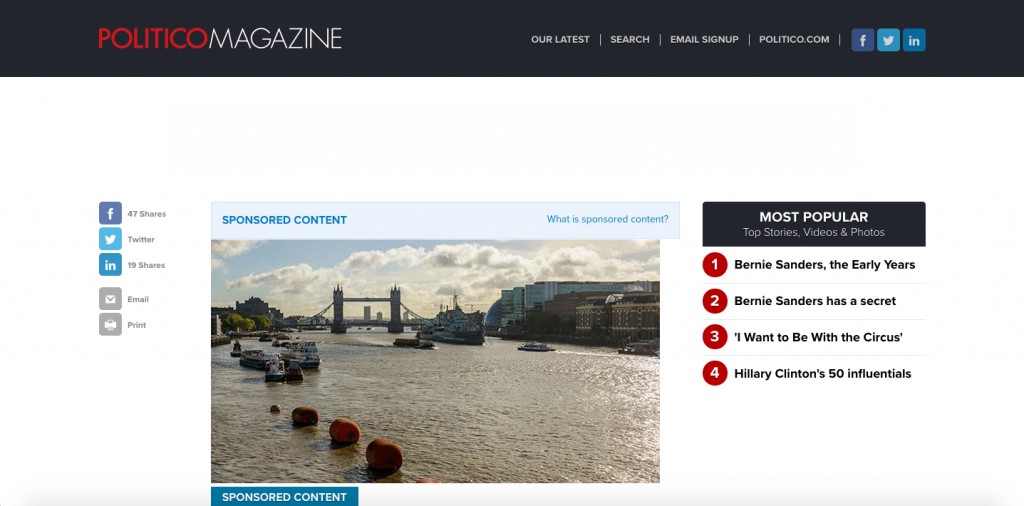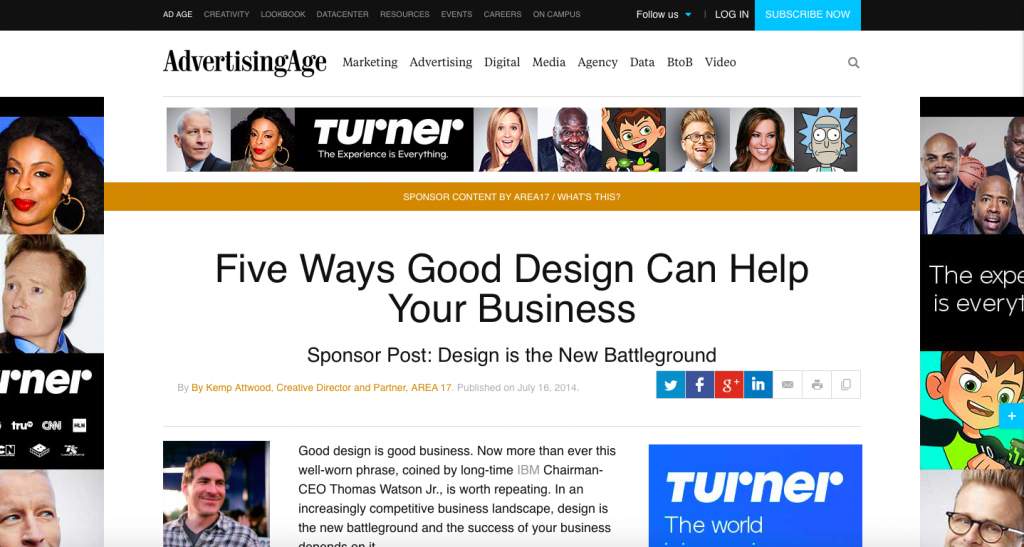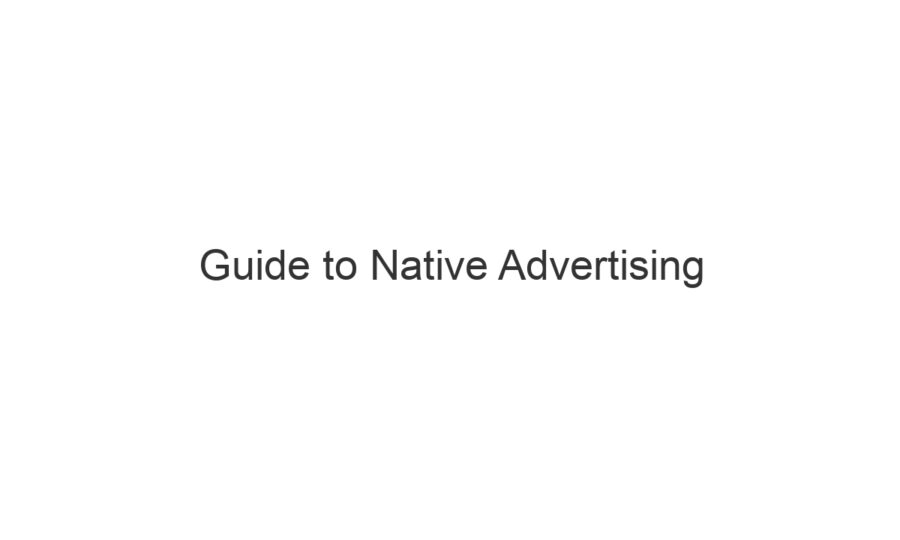Over the past few years, ad-blocking technology has had massive boost in consumer adoption, seeing a 30 percent growth spurt in 2016 alone. At the same time, both banner and interstitial ads have seen declining appeal from consumers and advertisers alike. They are often perceived to ruin the user’s browsing experience, leading to bad results for the advertiser.
10 years ago, B2B agencies weren’t a thing – but they have grown significantly off the increased demand. All businesses now must communicate online and now face greater competition than ever. Which is why many are seeking the benefits of native advertising, to help cut through, to deliver brand and performance.
Native advertising delivers a less obtrusive, more organic user experience. Advertisers have seen an 18 percent lift in purchase intent, along with other indications suggesting that native is, by far, the more favorable choice.
For more on the latest research, see our State of Content.
Native advertising is also said to help ecosystems that feature longer buying journeys, making it an especially appealing format for B2B marketers.
What is Native Advertising?
There’s a clear terminology problem in the industry, so in an attempt to add some clarity and by leaving social media ads out of it too, there are three categories that you should know about:
Branded Content
These are articles that look like editorial content, but that has been sponsored by a brand on a publisher site, such as BuzzFeed, HuffPost, NYTimes and so forth. They can be created by the brand itself, or the publisher’s content studio team. This category, is what the majority of people think about when they’re referring to ‘native ads’.
In-feed Native Distribution
This is an ad format used to seamlessly present content (user-generated or sponsored content) to users, in different environments such as Content feeds (i.e. editorial sites, feed reader apps, and other content-focused apps designed with a news feed of articles, images, videos, or music), Product Feeds (i.e. sites and apps that display product listings, service listings, or app listings.) and Social Feeds (i.e. include users’ posts, businesses’ posts, articles, photos, videos, and status updates.).
Content Recommendation
This is when a brand pays to have their content promoted by a discovery network like Outbrain and Taboola. The content appears in the discovery module alongside organic content.
In this post, we’ve picked out real examples of advertisers doing branded content well, along with watch-outs and best practices in the B2B space.
Contact your Nudge account manager today to learn how native can work for you.
B2B Campaigns We ❤️
Facebook: Facebook Wants to Help Make Your App Super Smart
Things we liked:
This piece is a breath of fresh air, it looks great and their approach is smart.
You can tell that they are aiming to get in front of the ‘app maker entrepreneur’, not just people getting started with developing apps. It’s important to be clear about who you’re aiming to help, and how you can help them – if you dilute your message, you might miss your opportunity.
The content has a cohesive experience, they’ve got visuals that make sense and it looks good on both mobile and desktop. It also loads quickly, especially on mobile.
Even though the call to action is too far down, there are multiple links throughout, ensuring they’re getting quality traffic through to their site, which is great.
They’ve also included a video (integrated Facebook video – makes sense). Through Nudge Benchmarks, we know that video + article drives the highest conversion rate.
Native changes fast, keep up to speed with the latest trends through our native research reports.
Downsides:
As soon as you land on the article, you see ads from competitive brands. This is definitely a negative when it comes to brand safety, but you also wouldn’t want your competitors to ride on the back of your campaign’s success. This becomes especially problematic on the mobile version of the article, as a competitive ad is featured at the bottom end of the content, interrupting the flow which could mean that people don’t see their final call to action.
Oracle: From Accountants To Rockstars
Things we liked:
This is a nicely integrated piece of content, it’s cohesive and lifts the brand. For B2B, native is a golden opportunity to share your market perspective and how you fit in, so don’t shy away from doing it. They’ve done a good job of it in this article. The publisher is a nice fit, it feels custom made and the content is rich and fits nicely with their audience.
Another positive standout here are the photos. When it comes to B2B, imagery is usually a problem – i.e. ‘the same old stock photo’ syndrome.
Compared to the Facebook article, it doesn’t feature any other advertising, which is great – getting an exclusive across the publication is important when it comes to brand safety. And you don’t want your competitors to ride the wave of success that could come out of your campaign.

Downsides:
Two headlines are featured in the article, the first one being ‘From Accountants To Rock Stars’ and the second, ‘How Real-Time Data Analytics Transform The Role Of Finance’. We found the second headline to be more inline with what the rest of the article is about and we often tell our clients that even if a campaign has gone live, the headline can change, and should change if the data supports it.
The article takes a long time to load, which means that they’re potentially losing buyers before they’ve read a single word of their content. From Nudge data, we can see this impacting as high as 60% of users leaving the content before it loads and given that their audience primarily consists of CFO’s, i.e. busy people, it could have negative implications.
Visually the piece looks nice, but unfortunately, it looks messy on desktop. It’s clearer on mobile but because of the features, it takes a while to load. Speaking of cross-device, advertisers want to make sure you can reach your audience on different devices throughout the day, which is especially true in B2B, something we feel could have been done better in this campaign.
The content only has one call to action, we’d like to have seen multiple throughout. According to Nudge Benchmarks, people on average scroll 64 percent of an article. Seeing as their main call to action is featured at the bottom of the content, it will have been missed by many. The moving units would have been a good place to feature call to actions, as people stop and dwell for a bit.
The following articles have previously featured in our lists covering the best native ads over the past few years.
- Best Native Ads of 2018 (updated on a weekly basis)
- Best Native Ads of 2017
- Best Native Ads of 2016
- Best Native Ads of 2015
JPMorgan Chase & Co: The Subway That Connects Two Continents
Things we liked:
This piece targets a niche crowd around a high-value niche service. Good placement and great long-form content for the audience. It shows the power of native content to reach people where they’re reading and introduce new eyeballs.

AREA17: Five Ways Good Design Can Help Your Business
Things we like:
This is one of our favorites in a B2B context, Area 17 a design agency, bought this placement of a thought leadership piece. It puts them in a good light in front of their key audience, it’s not a BuzzFeed-type post but more thoughtful and considered for their clients. The exact thing they’re looking for.

B2B Native Advertising Watch-Outs
- Ensure your partner has turned off the ad service for competing ads.
- Load time.
- Images is something that B2B brands struggle with – don’t just pick the first image from stock photos.
- Be specific with your headlines, you only want to pull in the right people.
- Not being overt enough – you’ve pulled in a specific audience around a topic, make sure your brand is well integrated.
- Make sure you distribute the content on your own channels as well and use as sales collateral.
Best practices
The evergreen nature of native ads
Native content continues to live on after a campaign has finished.
For example, in a recent campaign, one of our client’s saw the following results after the campaign had ‘finished’:
- Social engagement increased from 5% to 35%.
- The content continued to drive conversions at a competitive rate after the campaign finished.
So make sure you factor this in when you create your content and that you use your content as a sales tool both short and long term.
Organic Traffic Increases
As with any piece of quality content, you’re bound to see traffic increase via Google search, meaning your campaign is going to live on after your paid distribution has finished.
In fact, a recent client of ours saw their attention double and social engagement increase 5x once the paid distribution of the campaign had finished. Meaning that your content will live on past it’s ‘campaign’ dates. Because of this it’s essential to not just forget about the piece of content once the paid distribution has finished. Keep tracking behavioural metrics and keep tracking conversions, to truly judge the success of the content.
Quality over quantity
Quality is evermore important. Marketers need to check that people consume the content, otherwise it’s just wasteful. Content is good for B2B brands as their offering can be complex, it allows people to get information that they wouldn’t otherwise have grasped from a banner ad.
Take the stage and share your story
Every brand has a unique way they view their market – content gives them the stage to share theirs. It allows marketers to tell a much more complex story.
Make use of flexible geo-distribution options
B2B can be quite geographically focused. You can either look for distribution locally or nationally – which is great because they can get on a publisher like Entrepreneur but only focus distribution on San Francisco for example. Or you can work with publishers like Business Journals who have regional publications and sites.
Match the style of your environment
It’s important to ensure that you’re understanding what your audiences find shareable, on the publisher/s that you’ve partnered with, and try to craft content that is similar.
This VMWare piece with Re:Think talking about how smart technology can benefit factory workers, is a good example of pulling in The Atlantic audience with smart content and relating it to how VMWare can help.
Make it clear your ad is an ad
Ensure that your branded content is labeled as an ad, to ensure that you don’t annoy/trick the reader. At the same time, it’s important that your article has the editorial look and feel, so it feels like it belongs on the site, i.e. matches its environment.
Interestingly, Contently performed a focus group around native advertising, and the most clearly labeled ad was also the most effective: 83% of readers identified the content as an ad, and 56% of them were more likely to purchase the product after reading it. Win/win!
Conclusion
In short, success in B2B is not always about scale, persuading 10 people to buy your product, means it can have a massive impact on your brand’s ROI. It’s important to optimize based on data and to really make sure your content is of the highest quality.
If you’d like to see how Nudge helps B2B brands succeed in native, reach out to a Nudge account manager.

|
|---|
 Skip to content
Skip to content

